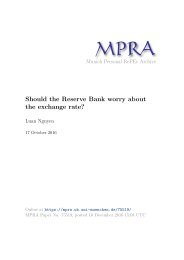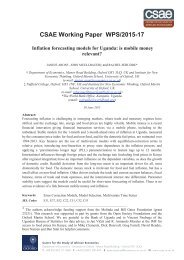debtequity
n?u=RePEc:red:sed016:1511&r=cba
n?u=RePEc:red:sed016:1511&r=cba
Create successful ePaper yourself
Turn your PDF publications into a flip-book with our unique Google optimized e-Paper software.
that the Central Bank makes a loss for sure which has to be paid by taxpayers: we eliminate this<br />
case. In case (ii) where R D = R B the Flex equilibrium (defined below) reduces to the banking<br />
equilibrium studied in Section 3 with π = 0. Since we are interested in high-safe-asset demand<br />
(HS) economies in which the standard banking equilibria are inefficient, we also eliminate this case.<br />
We thus focus on case (iii) where R D > R B . When the realized outcome a of the bank’s payoff ã<br />
is favorable i.e. when Ka ≥ R D D (where K denotes the capital invested by the banks), then the<br />
Central Bank makes a profit (R D − R B )D. This profit is transferred to the Treasury which uses it<br />
to reduce taxes. However when the realized outcome a is low i.e. when Ka < R D D, banks default<br />
and the Central Bank recovers the value (1 − γ f )Ka of the bank’s assets and the Treasury raises<br />
taxes to reimburse depositors and cash funds. Thus the taxes paid by investors at date 1 are given<br />
by<br />
t(a) =<br />
{<br />
R B B − (R D − R B )D, if Ka ≥ R D D<br />
R B B − ((1 − γ f )Ka − R D D),<br />
if Ka < R D D<br />
The first term is the cost of reimbursing the Treasury’s debt B, and the second is the profit or loss<br />
made by the Central Bank acting as the banks’ banker.<br />
Agents Depositors behave as in Section 3 facing the "discounted" interest rate R d = RB<br />
1+µ<br />
i.e. the<br />
riskless rate R B discounted by the cost µ of managing their funds at date 1. Cash funds behave<br />
as in Section 3 facing the interest rate R c = R B . Investors behave as in Section 3 anticipating the<br />
expected return on equity R E = Φ(α; R D ).<br />
Equations of Flex equilibrium<br />
(19)<br />
An equilibrium of the Flexible (100%) Reserve System consists<br />
of interest rates (R B , R D ), equity requirements α, rate on return on equity R E , and actions<br />
(d, c, e, K, D, E) such that<br />
(i) u ′ d (w d 0 − d) = 1 + ρ<br />
1 + µ RB ⇔ d = d(R B )<br />
(ii) u ′ c(w c 0 − c) = R B ⇔ c = c(R B )<br />
(iii) D = d + c − B<br />
(iv) E =<br />
α<br />
1 − α D, 1<br />
α<br />
∫ ∞<br />
(1−α)R D (a − (1 − α)R D )f(a)da = R E , R E ≥ E(ã), K = D + E<br />
(v) e = E, u ′ i (w i 0 − e) = R E ⇔ e = e(R E )<br />
(vi) x i1 (a) = w i1 − t(a) + V (a)e with V (a) given by (6) and t(a) by (19).<br />
As we have seen in Section 3, there are two sources of inefficiency in a standard banking<br />
equilibrium of a high-debt economy. The first is that the interest rate and the return on equity<br />
35





